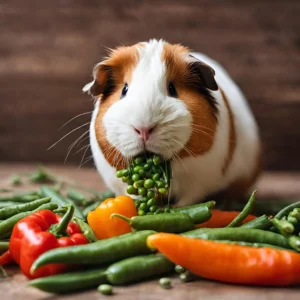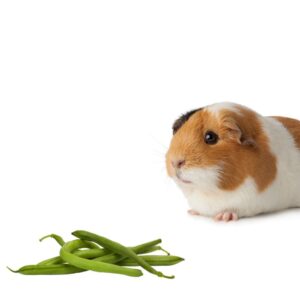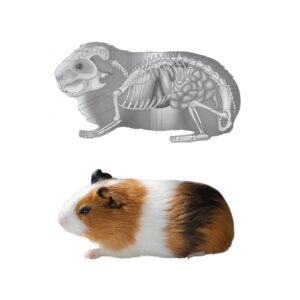Guinea pigs are one of the friendliest and most gentle animals to keep for pets. But they’re not only cute rodents we like to snuggle with.
They’re fascinating animals domesticated for over 5,000 years, giving us enough time to learn the most incredible guinea pig facts.
Let’s dive into more or less known facts.
Table of Contents
Guinea Pigs Have a Third Eyelid
Guinea pigs have a third eyelid known as the nictitating membrane, a handy shield against dirt, dust, and potential eye irritants.
This membrane allows them to swiftly close their eye while eating, playing, or zipping around. But it also promotes overall eye health by preventing the cornea from drying out and whisking away any debris.
Should you spot your guinea pig’s nictitating membrane closed for an extended period, it may indicate an eye issue. In this case, schedule a vet visit as soon as possible.
To maintain your piggy’s eyes healthy, follow these tips:
- Regularly inspect your guinea pig’s eyes for redness, discharge, or swelling.
- If their eyes gather dirt or dust, gently wipe them with a damp cloth.
- Steer clear of harsh chemicals or soaps—keep it gentle.
Their Toes Count is Fascinating
These ‘’squeeky’’ rodents have four toes on each front foot and three on each back foot, making it easier for them to run, jump, and climb objects.
The front toes, being the longest and sturdiest, are the go-to for running and leaping. While, the back toes, shorter and less robust, come into play for digging, burrowing, and keeping that fur on point.
As for the inner toe on the back foot, it’s significantly weaker and doesn’t pull much weight.
Guinea Pigs Are Clean and Groom Themselves Regularly
With their thick fur, guinea pigs are like magnets for dirt, dust, and pesky parasites. Grooming is mandatory for their well-being.
Guinea pigs love grooming to keep that fur clean, shiny, and in tip-top health. This self-care routine isn’t just about looks – it’s their way of bonding with fellow companions.
They Don’t Sweat
Guinea pigs don’t sweat since they don’t have any sweat glands. But they’re pros when it comes to grooming themselves.
Licking their fur isn’t just a fashion statement; it’s their way of beating the heat – the moisture evaporates after licking, so they use this as a cooling solution during high-temperatures.
Guinea Pigs Have Long Pregnancies
Guinea pigs are pregnant for about 68 days and usually give birth to litters of two to four babies.
The gestation period for guinea pigs is relatively long compared to other small mammals and rodents. Since they are pray animals, they need to give birth to well-developed babies that can fend for themselves quickly.
Here are some signs that your guinea pig might be pregnant:
- Weight gain
- Enlarged abdomen
- Decreased activity level
- Nesting behavior
If you notice any of these signs in your guinea pig, take them to the vet to learn about care during this time.
Guinea Pig Babies Are Called Pups
Guinea pig pups are born blind and hairless, but they develop quickly and can eat solid food few days of birth. Guinea pig mothers are attentive to their pups and will nurse them for several weeks.
The pups will usually stay with their mother until they are about 6-8 weeks old. Here are some tips for caring for guinea pig pups:
- Provide the pups with a warm and safe place to live. You can use a nesting box filled with hay and bedding.
- Make sure the pups have access to fresh water and hay at all times. You can also offer them a variety of vegetables and fruits.
- Handle the pups gently and avoid stressing them.
- Clean the pups’ bedding regularly to prevent the spread of disease.
- Take the pups to the vet for regular checkups.
Safety guidelines:
- Be gentle with the pups and avoid stressing them.
- Keep the pups in a safe and clean environment.
- Make sure the pups have access to fresh water and hay at all times.
- Take the pups to the vet for regular checkups.
Guinea Pigs Are Prey Animals
Guinea pigs are prey to hawks, owls, coyotes, and foxes. This is because guinea pigs are relatively small and defenseless animals. They don’t have sharp teeth or claws dont run fast.
But they developed some defense mechanisms. For example, they are incredibly good at hiding. They also have excellent hearing and vision, helping them to detect predators early.
However, guinea pigs are still vulnerable to predation even with these adaptations.
If you have guinea pigs and decide to keep them outside, it’s critical to take extra security measures to protect them from predators. Here are some tips:
- Keep your guinea pigs in a secure enclosure, such as a hutch or cage.
- Make sure the enclosure is well-ventilated and has plenty of hiding places.
- Avoid placing the enclosure near areas where predators are common.
- Be aware of the signs that a predator may be nearby, such as strange noises or tracks.
Incas Domesticated Guinea Pigs Over 5,000 Years Ago
Yes, that’s right – Incas were the first people to domesticate guinea pigs in South America over 5,000 years ago. They initially raised them for meat and fur sources, but these cute little rodents quickly became popular as pets.
Spanish Conquistadors Brought Guinea Pigs to Europe
Spanish conquistadors were the first to bring and introduce guinea pigs to European people in the 16th century. The piggies quickly became popular pets all over Europe.
Today, guinea pigs are still popular pets all over the world. People love them for their gentle nature, intelligence, and cute appearance.
Scientists Used and Still Use Guinea Pigs for Research
We at My Senior Paws stand against animal testing. We support brands and products that find alternative ways to bring safe products to the market.
Italian biologists Marcello Malpighi and Carlo Fracassati performed vivisections on guinea pigs to explore anatomical structures. In 1780, Antoine Lavoisier included guinea pigs in his calorimeter experiments, a tool for measuring heat production.
In the late 19th century, guinea pigs were crucial in establishing germ theory through experiments by Louis Pasteur, Émile Roux, and Robert Koch.
Scientists use guinea pigs in research because they’re physiologically similar to humans and take less time to breed. Guinea pigs have contributed to studies on diseases like:
- Cancer
- heart disease
- Diabetes
- Asthma
- Tuberculosis
- Malaria
- HIV/AIDS
- Nutritional deficiencies
- Mental health disorders
Guinea pigs remain part of scientific research, with increased regulations requiring scientists to obtain ethics board approval before conducting animal experiments. And today, they’re helping in researching problems with:
- Allergies
- Respiratory diseases
- Hearing
- Nutrition
Guinea Pigs Are Intelligent Animals

Guinea pigs are intelligent animals, and many experienced piggy parents train them to perform simple tasks. They are quick learners and are motivated by food rewards.
Here are some examples of how guinea pigs demonstrate their intelligence:
Learning tricks: Guinea pigs can be trained to perform simple tricks like running through a maze or responding to commands.
Problem-solving: Guinea pigs can figure out how to open doors, get to food that is out of reach, and escape from enclosures.
Remembering sounds: Guinea pigs can associate sounds with specific events, such as the sound of their food tray being opened or their owner’s voice.
Recognizing their owners: Guinea pigs can recognize their owners by sight, scent, and sound.
Forming strong bonds: Guinea pigs can form strong bonds with their owners and other guinea pigs.
Spatial awareness: Guinea pigs can remember the layout of their surroundings and use this information to find their way around.
Learning from observation: Guinea pigs can learn new things by observing other guinea pigs or humans.
These are just a few examples of how guinea pigs demonstrate their intelligence. You can teach your guinea pig many new things with patience and training.
Here are some tips for helping your guinea pig learn and stay mentally stimulated:
- Provide them with plenty of toys and activities.
- Play with them regularly.
- Teach them tricks.
- Let them explore their surroundings.
- Expose them to new experiences.
Guinea Pigs Aren’t Pigs
Contrary to their name, guinea pigs are not pigs at all. They are part of the rodent family, sharing their ancestry with chinchillas and porcupines. These cute animals earned their name due to their plump, pig-like bodies.
Relatively Long Lifespan
These fuzzy rodents typically live around five to seven years. And with exceptional care, some piggies can even surpass the age of eight.
A balanced diet, a clean environment, and regular veterinary check-ups are vital in ensuring they have a long and happy life.
Guinea Pigs Do Have Tails…Sort of
Due to their exterior look, most people think that guinea pigs don’t have tails. But the truth is: guinea pigs have tails!
However, their tails are not external. More precisely, guinea pigs have vestigial tails, meaning it’s a tail that became reduced with evolution, and it doesn’t extend to the exterior of a guinea pig’s body.
On the other hand, some long-haired piggies like Lankarya and Peruvian have significantly longer ‘’cowlicks’’ on their hair compared to other breeds – often called rosettes.
These rosettes give the illusion of a tail on the end of their backs, so don’t be confused when you see one of these cute furballs.
World Record Achievers
A male guinea pig called ‘’Snowflake’’ holds the Guinness World Record for the oldest guinea pig ever lived. He was 15 years old.
They Have Sensitive Snouts
The sensitive and twitching noses help them explore and familiarize themselves with the environment.
These little snouts can move independently, allowing them to gather information about scents and textures, helping them navigate their surroundings and detect environmental changes.
They Are A Night Vision Masters
Guinea pigs have remarkable night vision, a trait inherited from their wild ancestors who were crepuscular, meaning they were most active during the dawn and dusk hours.
This adaptation helps them navigate their surroundings in low light conditions, ensuring they remain alert and aware, even during the darker hours – especially important for piggies who live in the wild or pets who spend most of their time outdoors, in areas with potential predators.
Guinea Pigs Whistle While They Work…Kind of
“Wheeking” is a high-pitched sound similar to whistling. It is usually followed by excited jumps and rapid movements to express anticipation or excitement, especially when they associate certain sounds or actions with the food or treats.
Theodore Roosevelt carried his piggy in a basket
US President Theodore Roosevelt had guinea pigs for pets. He named five guinea pigs ‘Admiral Dewey’, ‘Dr Johnson’, ‘Bob Evans’, ‘Bishop Doan’ and ‘Father O’Grady’.
You can learn more about this story at the Presidential Museum.
They are Vocal Communicators
Guinea pigs are fantastic vocal communicators. They use a range of sounds to express themselves. You’ll hear them squeak when excited, weak when they’re hungry, hear the sounds of a fridge opening, rumble when they feel uncomfortable, and even purr when they’re being affectionate.
They are Incredibly Social
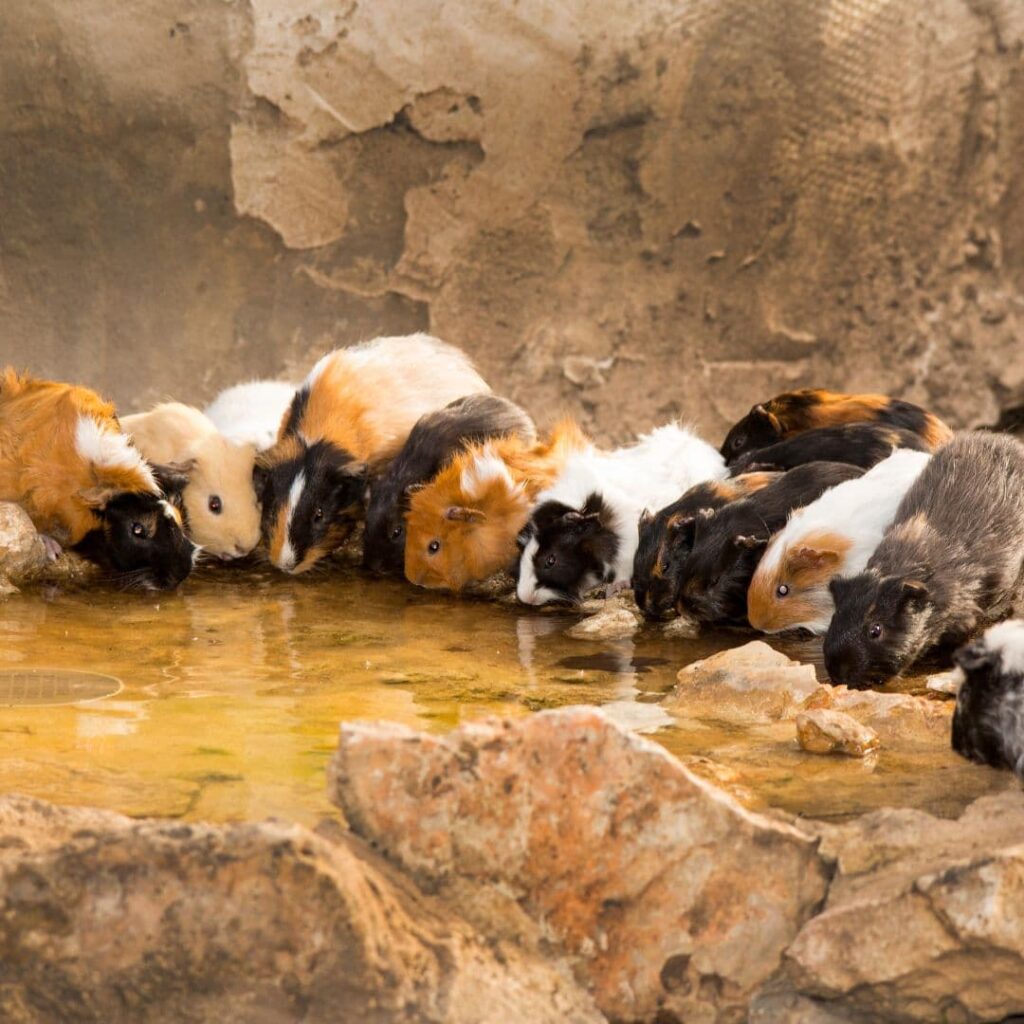
They live in herds and communicate through vocalizations and body language in the wild.
These interactions help them to maintain social bonds, coordinate foraging and predator avoidance, and reduce stress.
Domestic guinea pigs also benefit greatly from social interaction. They enjoy cuddling, playing, and grooming each other, and they can become quite lonely if they are kept alone.
Studies have shown that guinea pigs who live with companions are less stressed, more active, and have fewer health problems than those who live alone.
Here are some of the ways that guinea pigs socialize:
Vocalizations: Guinea pigs make a variety of vocalizations, including squeaks, whistles, and rumbles. These vocalizations can be used to express various emotions, including happiness, fear, and aggression.
Body language: Guinea pigs also communicate with each other through body language. For example, they may hunch their backs and flatten their ears to show submission or raise their heads and puff out their chests to show dominance.
Grooming: Guinea pigs spend a lot of time grooming each other. This behavior helps to strengthen social bonds and remove dirt and parasites from their fur.
Playing: Guinea pigs enjoy playing with each other. They may chase each other, wrestle, or play with toys.
Guinea pigs can form strong bonds with their owners
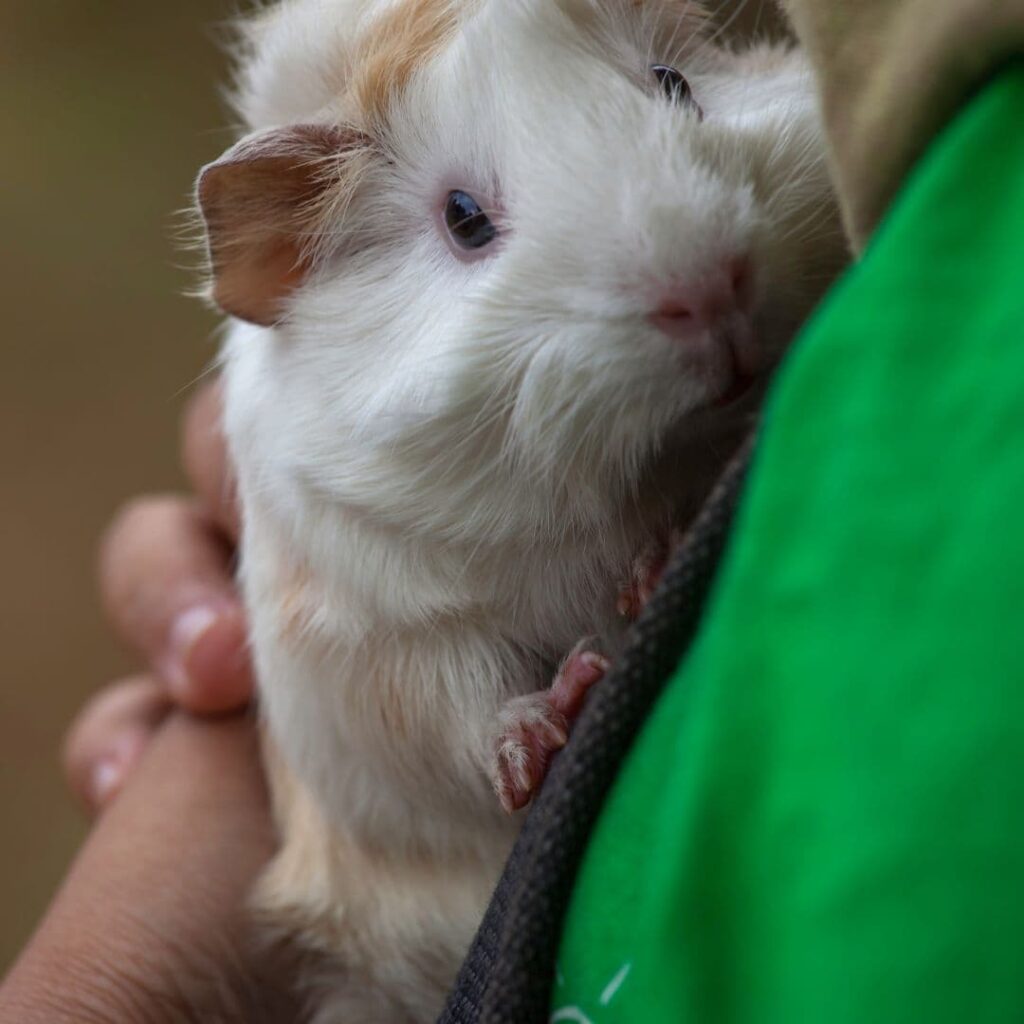
They are intelligent animals that can recognize their caregivers and associate them with positive experiences, such as being fed, stroked, and played with.
Over time, guinea pigs can learn to trust their owners and become comfortable around them. They may even show signs of affection, such as purring, licking, or nuzzling.
Here are some signs that your guinea pig loves you:
They greet you when you come home. Guinea pigs can learn to recognize the sound of your voice or footsteps and may come to the front of their cage to greet you when you enter the room.
They enjoy being petted. Guinea pigs may purr or nuzzle you when you pet them, which is a sign that they are enjoying the interaction.
They follow you around. Guinea pigs may follow you around the room or cage, which is a sign that they are interested in what you are doing and want to be close to you.
They lick you. Guinea pigs may lick you as a sign of affection or grooming.
They chatter to you. Guinea pigs may chatter to you as a way of communicating with you.
Of course, every guinea pig is an individual; some may be more affectionate than others.
There are over 20 Unique Breeds
All guinea pig breeds have their unique characteristics and appearance. For instance, the Abyssinian guinea pig is known for its distinctive rosettes or whorls in its fur. On the other hand, skinny pigs are hairless guinea pigs, which are adorable and intriguing.
They Are Herbivores
Guinea pigs are herbivore animals, meaning they feed on plant-based food. Primarily, guinea pigs eat crunchy veggies such as cucumbers and carrots. A guinea pig’s diet should include green veggies, fruit, orchard hay, timothy hay, pellets from a high-quality brand, and plenty of water.
Special Need for Vitamin C
A guinea pig can’t naturally produce vitamin C in its body. When keeping guinea pigs for pets, providing them with enough vitamin C throughout the day is critical.
This is especially important for guinea pigs who are pregnant or nursing, as they have increased vitamin C needs.
To avoid common health issues like scurvy, bell peppers, green beans, and supplements can greatly help their vitamin C deficiency.
Pro tip: If you are concerned that your guinea pig may not get enough vitamin C, you should talk to your veterinarian about supplementing them.
Continuously Growing Teeth
Four of 20 teeth are incisors (two incisors on each jaw), four are premolars, and 12 aremolars.
While incisors help them to cut the food down into smaller pieces, premolars and morals help them chew it down.
Their teeth are ever-growing (especially incisors), making them dangerous for their well-being, so they must constrain and wear them down by chewing.
They are Extremely Sensitive and Prone to Health Issues
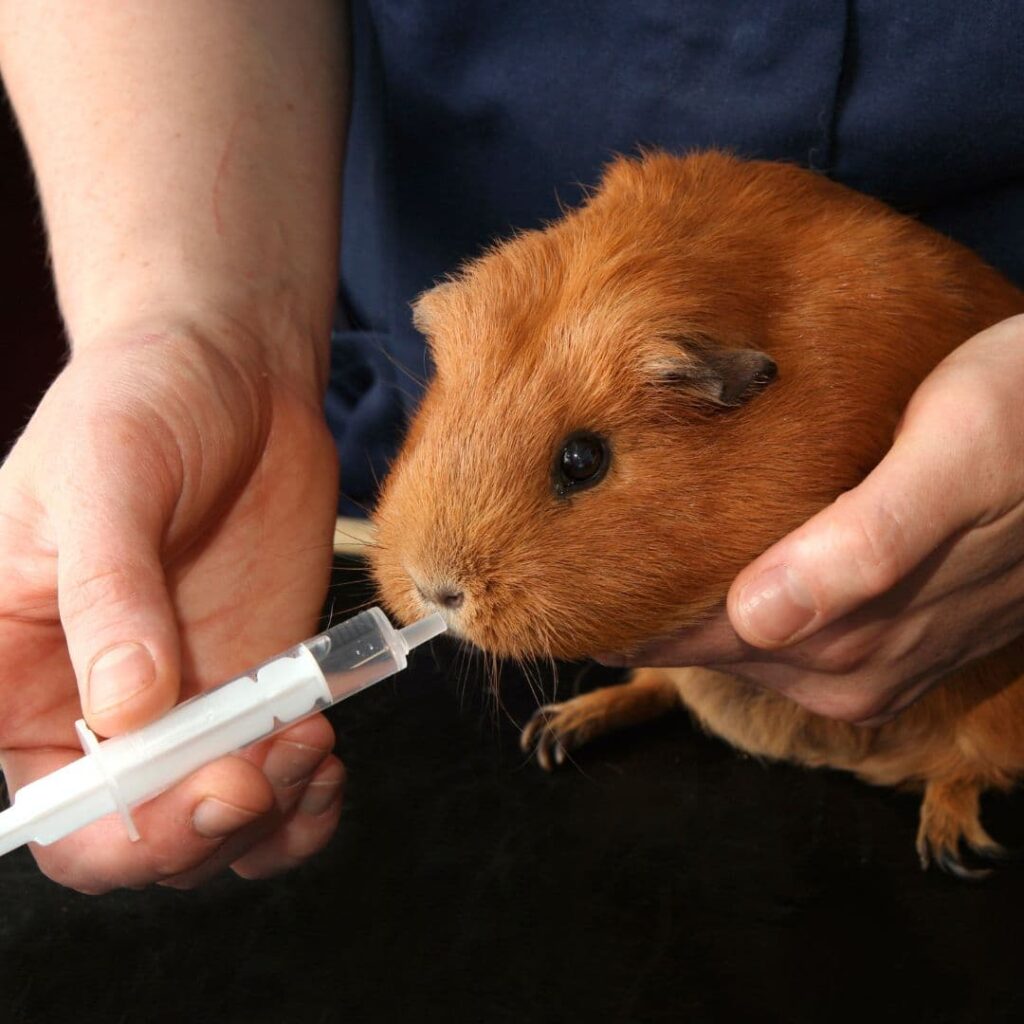
Guinea pigs are extremely sensitive critters, often prone to injuries and infections. But with a healthy diet, proper living conditions, plenty of physical and mental stimulation, and safe handling, you can keep them safe and sound.
Dental problems: Guinea pigs have teeth that grow continuously throughout their lives. If their teeth are not properly worn down, they can cause pain, difficulty eating, and infection.
Urinary tract infections: Guinea pigs are prone to urinary tract infections, especially if they don’t have access to enough fresh water or if their cage is not kept clean.
Respiratory infections: Guinea pigs are also susceptible to respiratory infections, such as pneumonia and bronchitis
High Level of Stress: Since they can be anxious with new surroundings, people, or even companions in the habitat, guinea pigs are easily scared and can become anxious. This can lead to stress, causing changes in behavior and panicking, and it can even be fatal in some cases.
For instance, if their partner dies, they are at risk of a shorter lifespan. But remember that every piggy is different and has its characteristics, meaning that some of them may not be affected by these situations – which is normal.
They Don’t Hibernate
Unlike some small animals, guinea pigs don’t hibernate. They require a consistent, warm environment, especially during colder seasons, to prevent health issues associated with temperature fluctuations. A cozy, insulated space ensures their well-being and comfort throughout the year.
They are Fuzzy Therapists
Due to their gentle nature and attentiveness, guinea pigs can be amazing companions for people.
Spending quality time with these gentle critters, petting them, and enjoying their soothing sounds can have a calming influence on individuals with psychological and emotional problems, potentially reducing stress.
Potty Trained Pros
A lot of people wouldn’t think about this but, remarkably, guinea pigs can be litter trained. Like cats, they designate a specific corner of their cage for bathroom activities, making the cleaning process a bit more manageable for their human companions.
If you’re curious and would like to train your guinea pig, you can teach them how to use a litter box – this will also help maintain good hygiene in their habitat.
Here are the steps you should follow:
- Place the litter box in a corner of their cage.
- Fill it with hay or other litter material.
- Place some of your guinea pig’s droppings in the litter box to help them learn where to go.
- After they use the box, give them a treat and pet them.
They Are Nap Enthusiasts
Although guinea pigs are active for about 20 hours daily and rarely sleep, they love taking short naps throughout the day. Creating a quiet, comfortable space with cozy hideouts contributes significantly to their well-deserved rest and relaxation.
My Senior Paws is a participant in the Amazon Services LLC Associates Program, an affiliate advertising program designed to provide a means for sites to earn advertising fees by advertising and linking to Amazon.com. We also participate in other affiliate programs which compensate us for referring traffic.

